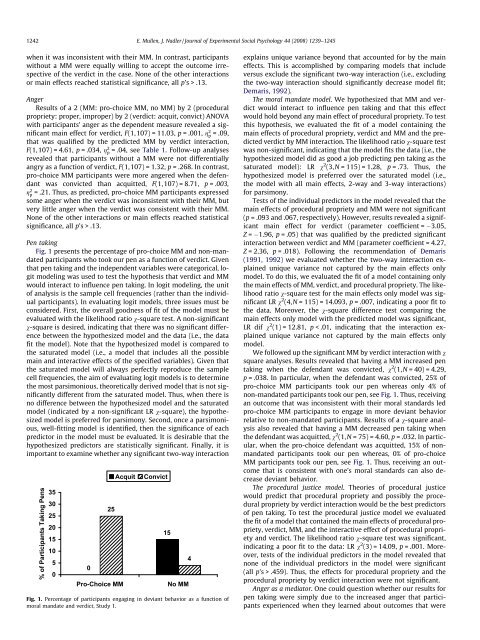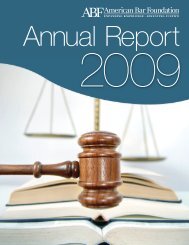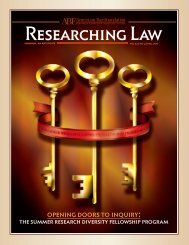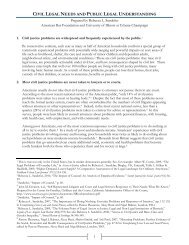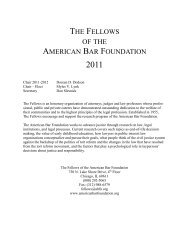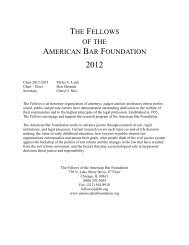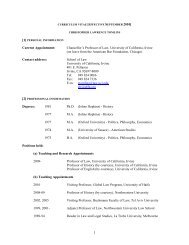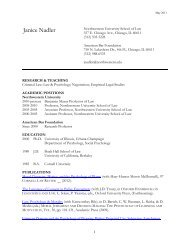1242 E. Mullen, J. Nadler / Journal <str<strong>on</strong>g>of</str<strong>on</strong>g> Experimental Social Psychology 44 (2008) 1239–1245when it was inc<strong>on</strong>sistent with their MM. In c<strong>on</strong>trast, participantswithout a MM were equally willing to accept the outcome irrespective<str<strong>on</strong>g>of</str<strong>on</strong>g> the verdict in the case. N<strong>on</strong>e <str<strong>on</strong>g>of</str<strong>on</strong>g> the other interacti<strong>on</strong>sor main <str<strong>on</strong>g>effect</str<strong>on</strong>g>s reached statistical significance, all p’s > .13.AngerResults <str<strong>on</strong>g>of</str<strong>on</strong>g> a 2 (MM: pro-choice MM, no MM) by 2 (proceduralpropriety: proper, improper) by 2 (verdict: acquit, c<strong>on</strong>vict) ANOVAwith participants’ anger as the dependent measure revealed a significantmain <str<strong>on</strong>g>effect</str<strong>on</strong>g> for verdict, F(1,107) = 11.03, p = .001, g 2 p = .09,that was qualified by the predicted MM by verdict interacti<strong>on</strong>,F(1,107) = 4.61, p = .034, g 2 p= .04, see Table 1. Follow-up analysesrevealed that participants without a MM were not differentiallyangry as a functi<strong>on</strong> <str<strong>on</strong>g>of</str<strong>on</strong>g> verdict, F(1,107) = 1.32, p = .268. In c<strong>on</strong>trast,pro-choice MM participants were more angered when the defendantwas c<strong>on</strong>victed than acquitted, F(1,107) = 8.71, p = .003,g 2 p= .21. Thus, as predicted, pro-choice MM participants expressedsome anger when the verdict was inc<strong>on</strong>sistent with their MM, butvery little anger when the verdict was c<strong>on</strong>sistent with their MM.N<strong>on</strong>e <str<strong>on</strong>g>of</str<strong>on</strong>g> the other interacti<strong>on</strong>s or main <str<strong>on</strong>g>effect</str<strong>on</strong>g>s reached statisticalsignificance, all p’s > .13.Pen takingFig. 1 presents the percentage <str<strong>on</strong>g>of</str<strong>on</strong>g> pro-choice MM and n<strong>on</strong>-mandatedparticipants who took our pen as a functi<strong>on</strong> <str<strong>on</strong>g>of</str<strong>on</strong>g> verdict. Giventhat pen taking and the independent variables were categorical, logitmodeling was used to test the hypothesis that verdict and MMwould interact to influence pen taking. In logit modeling, the unit<str<strong>on</strong>g>of</str<strong>on</strong>g> analysis is the sample cell frequencies (rather than the individualparticipants). In evaluating logit models, three issues must bec<strong>on</strong>sidered. First, the overall goodness <str<strong>on</strong>g>of</str<strong>on</strong>g> fit <str<strong>on</strong>g>of</str<strong>on</strong>g> the model must beevaluated with the likelihood ratio v-square test. A n<strong>on</strong>-significantv-square is desired, indicating that there was no significant differencebetween the hypothesized model and the data (i.e., the datafit the model). Note that the hypothesized model is compared tothe saturated model (i.e., a model that includes all the possiblemain and interactive <str<strong>on</strong>g>effect</str<strong>on</strong>g>s <str<strong>on</strong>g>of</str<strong>on</strong>g> the specified variables). Given thatthe saturated model will always perfectly reproduce the samplecell frequencies, the aim <str<strong>on</strong>g>of</str<strong>on</strong>g> evaluating logit models is to determinethe most parsim<strong>on</strong>ious, theoretically derived model that is not significantlydifferent from the saturated model. Thus, when there isno difference between the hypothesized model and the saturatedmodel (indicated by a n<strong>on</strong>-significant LR v-square), the hypothesizedmodel is preferred for parsim<strong>on</strong>y. Sec<strong>on</strong>d, <strong>on</strong>ce a parsim<strong>on</strong>ious,well-fitting model is identified, then the significance <str<strong>on</strong>g>of</str<strong>on</strong>g> eachpredictor in the model must be evaluated. It is desirable that thehypothesized predictors are statistically significant. Finally, it isimportant to examine whether any significant two-way interacti<strong>on</strong>% <str<strong>on</strong>g>of</str<strong>on</strong>g> Participants Taking Pens35302520151050025Pro-Choice MMAcquitC<strong>on</strong>vict15No MMFig. 1. Percentage <str<strong>on</strong>g>of</str<strong>on</strong>g> participants engaging in <strong>deviant</strong> <strong>behavior</strong> as a functi<strong>on</strong> <str<strong>on</strong>g>of</str<strong>on</strong>g><str<strong>on</strong>g>moral</str<strong>on</strong>g> mandate and verdict, Study 1.4explains unique variance bey<strong>on</strong>d that accounted for by the main<str<strong>on</strong>g>effect</str<strong>on</strong>g>s. This is accomplished by comparing models that includeversus exclude the significant two-way interacti<strong>on</strong> (i.e., excludingthe two-way interacti<strong>on</strong> should significantly decrease model fit;Demaris, 1992).<str<strong>on</strong>g>The</str<strong>on</strong>g> <str<strong>on</strong>g>moral</str<strong>on</strong>g> mandate model. We hypothesized that MM and verdictwould interact to influence pen taking and that this <str<strong>on</strong>g>effect</str<strong>on</strong>g>would hold bey<strong>on</strong>d any main <str<strong>on</strong>g>effect</str<strong>on</strong>g> <str<strong>on</strong>g>of</str<strong>on</strong>g> procedural propriety. To testthis hypothesis, we evaluated the fit <str<strong>on</strong>g>of</str<strong>on</strong>g> a model c<strong>on</strong>taining themain <str<strong>on</strong>g>effect</str<strong>on</strong>g>s <str<strong>on</strong>g>of</str<strong>on</strong>g> procedural propriety, verdict and MM and the predictedverdict by MM interacti<strong>on</strong>. <str<strong>on</strong>g>The</str<strong>on</strong>g> likelihood ratiov-square testwas n<strong>on</strong>-significant, indicating that the model fits the data (i.e., thehypothesized model did as good a job predicting pen taking as thesaturated model): LR v 2 (3,N = 115) = 1.28, p = .73. Thus, thehypothesized model is preferred over the saturated model (i.e.,the model with all main <str<strong>on</strong>g>effect</str<strong>on</strong>g>s, 2-way and 3-way interacti<strong>on</strong>s)for parsim<strong>on</strong>y.Tests <str<strong>on</strong>g>of</str<strong>on</strong>g> the individual predictors in the model revealed that themain <str<strong>on</strong>g>effect</str<strong>on</strong>g>s <str<strong>on</strong>g>of</str<strong>on</strong>g> procedural propriety and MM were not significant(p = .093 and .067, respectively). However, results revealed a significantmain <str<strong>on</strong>g>effect</str<strong>on</strong>g> for verdict (parameter coefficient = 3.05,Z = 1.96, p = .05) that was qualified by the predicted significantinteracti<strong>on</strong> between verdict and MM (parameter coefficient = 4.27,Z = 2.36, p = .018). Following the recommendati<strong>on</strong> <str<strong>on</strong>g>of</str<strong>on</strong>g> Demaris(1991, 1992) we evaluated whether the two-way interacti<strong>on</strong> explainedunique variance not captured by the main <str<strong>on</strong>g>effect</str<strong>on</strong>g>s <strong>on</strong>lymodel. To do this, we evaluated the fit <str<strong>on</strong>g>of</str<strong>on</strong>g> a model c<strong>on</strong>taining <strong>on</strong>lythe main <str<strong>on</strong>g>effect</str<strong>on</strong>g>s <str<strong>on</strong>g>of</str<strong>on</strong>g> MM, verdict, and procedural propriety. <str<strong>on</strong>g>The</str<strong>on</strong>g> likelihoodratio v-square test for the main <str<strong>on</strong>g>effect</str<strong>on</strong>g>s <strong>on</strong>ly model was significantLR v 2 (4,N = 115) = 14.093, p = .007, indicating a poor fit tothe data. Moreover, the v-square difference test comparing themain <str<strong>on</strong>g>effect</str<strong>on</strong>g>s <strong>on</strong>ly model with the predicted model was significant,LR dif v 2 (1) = 12.81, p < .01, indicating that the interacti<strong>on</strong> explainedunique variance not captured by the main <str<strong>on</strong>g>effect</str<strong>on</strong>g>s <strong>on</strong>lymodel.We followed up the significant MM by verdict interacti<strong>on</strong> withvsquare analyses. Results revealed that having a MM increased pentaking when the defendant was c<strong>on</strong>victed, v 2 (1,N = 40) = 4.29,p = .038. In particular, when the defendant was c<strong>on</strong>victed, 25% <str<strong>on</strong>g>of</str<strong>on</strong>g>pro-choice MM participants took our pen whereas <strong>on</strong>ly 4% <str<strong>on</strong>g>of</str<strong>on</strong>g>n<strong>on</strong>-mandated participants took our pen, see Fig. 1. Thus, receivingan outcome that was inc<strong>on</strong>sistent with their <str<strong>on</strong>g>moral</str<strong>on</strong>g> standards ledpro-choice MM participants to engage in more <strong>deviant</strong> <strong>behavior</strong>relative to n<strong>on</strong>-mandated participants. Results <str<strong>on</strong>g>of</str<strong>on</strong>g> a v-square analysisalso revealed that having a MM decreased pen taking whenthe defendant was acquitted,v 2 (1,N = 75) = 4.60, p = .032. In particular,when the pro-choice defendant was acquitted, 15% <str<strong>on</strong>g>of</str<strong>on</strong>g> n<strong>on</strong>mandatedparticipants took our pen whereas, 0% <str<strong>on</strong>g>of</str<strong>on</strong>g> pro-choiceMM participants took our pen, see Fig. 1. Thus, receiving an outcomethat is c<strong>on</strong>sistent with <strong>on</strong>e’s <str<strong>on</strong>g>moral</str<strong>on</strong>g> standards can also decrease<strong>deviant</strong> <strong>behavior</strong>.<str<strong>on</strong>g>The</str<strong>on</strong>g> procedural justice model. <str<strong>on</strong>g>The</str<strong>on</strong>g>ories <str<strong>on</strong>g>of</str<strong>on</strong>g> procedural justicewould predict that procedural propriety and possibly the proceduralpropriety by verdict interacti<strong>on</strong> would be the best predictors<str<strong>on</strong>g>of</str<strong>on</strong>g> pen taking. To test the procedural justice model we evaluatedthe fit <str<strong>on</strong>g>of</str<strong>on</strong>g> a model that c<strong>on</strong>tained the main <str<strong>on</strong>g>effect</str<strong>on</strong>g>s <str<strong>on</strong>g>of</str<strong>on</strong>g> procedural propriety,verdict, MM, and the interactive <str<strong>on</strong>g>effect</str<strong>on</strong>g> <str<strong>on</strong>g>of</str<strong>on</strong>g> procedural proprietyand verdict. <str<strong>on</strong>g>The</str<strong>on</strong>g> likelihood ratio v-square test was significant,indicating a poor fit to the data: LR v 2 (3) = 14.09, p = .001. Moreover,tests <str<strong>on</strong>g>of</str<strong>on</strong>g> the individual predictors in the model revealed thatn<strong>on</strong>e <str<strong>on</strong>g>of</str<strong>on</strong>g> the individual predictors in the model were significant(all p’s > .459). Thus, the <str<strong>on</strong>g>effect</str<strong>on</strong>g>s for procedural propriety and theprocedural propriety by verdict interacti<strong>on</strong> were not significant.Anger as a mediator. One could questi<strong>on</strong> whether our results forpen taking were simply due to the increased anger that participantsexperienced when they learned about outcomes that were
E. Mullen, J. Nadler / Journal <str<strong>on</strong>g>of</str<strong>on</strong>g> Experimental Social Psychology 44 (2008) 1239–1245 1243inc<strong>on</strong>sistent with their MMs. Thus, we tested whether anger was asignificant predictor <str<strong>on</strong>g>of</str<strong>on</strong>g> pen taking. Results <str<strong>on</strong>g>of</str<strong>on</strong>g> a logistic regressi<strong>on</strong>with participants’ anger as the predictor variable and pen takingas the dependent variable revealed that anger was not a significantpredictor <str<strong>on</strong>g>of</str<strong>on</strong>g> pen taking, Odds ratio = 1.32, Wald-test = 0.95, p = .341.Given that anger was not a significant predictor <str<strong>on</strong>g>of</str<strong>on</strong>g> pen taking, angercould not mediate the <str<strong>on</strong>g>effect</str<strong>on</strong>g> <str<strong>on</strong>g>of</str<strong>on</strong>g> MM and verdict <strong>on</strong> pen taking.Study 1 discussi<strong>on</strong>Results <str<strong>on</strong>g>of</str<strong>on</strong>g> Study 1 revealed that pro-choice MM participantswere more likely to (a) be angered by the outcome, (b) rate the outcomeas less fair, (c) reject the outcome, and (d) walk away withour pen at the end <str<strong>on</strong>g>of</str<strong>on</strong>g> the experiment when the outcome <str<strong>on</strong>g>of</str<strong>on</strong>g> the caseopposed rather than supported their MM. Indeed, pen taking washighest when pro-choice MM participants learned about an outcomethat was inc<strong>on</strong>sistent with their <str<strong>on</strong>g>moral</str<strong>on</strong>g> standards and waslowest when pro-choice MM participants learned about an outcomethat was c<strong>on</strong>sistent with their <str<strong>on</strong>g>moral</str<strong>on</strong>g> standards. Thus, theseresults provide novel evidence <str<strong>on</strong>g>of</str<strong>on</strong>g> <str<strong>on</strong>g>moral</str<strong>on</strong>g> spillover; that is, outcomesthat are inc<strong>on</strong>sistent with people’s MMs increase their likelihood <str<strong>on</strong>g>of</str<strong>on</strong>g>engaging in <strong>deviant</strong> <strong>behavior</strong>. Moreover, results <str<strong>on</strong>g>of</str<strong>on</strong>g> Study 1 alsosuggest that outcomes that are c<strong>on</strong>sistent with <str<strong>on</strong>g>moral</str<strong>on</strong>g> standardsdecrease the likelihood <str<strong>on</strong>g>of</str<strong>on</strong>g> engaging in <strong>deviant</strong> <strong>behavior</strong>. Thus, supportingthe <str<strong>on</strong>g>moral</str<strong>on</strong>g> spillover hypothesis, whether outcomes are c<strong>on</strong>sistentor inc<strong>on</strong>sistent with <str<strong>on</strong>g>moral</str<strong>on</strong>g> standards influences people’stendency to engage in <strong>deviant</strong> <strong>behavior</strong>. It is also worth noting thatthe influence <str<strong>on</strong>g>of</str<strong>on</strong>g> MM and verdict <strong>on</strong> <strong>deviant</strong> <strong>behavior</strong> could not beaccounted for by the increased anger participants felt after learningabout outcomes that were inc<strong>on</strong>sistent with their MMs.Study 2Study 2 was designed to extend the results <str<strong>on</strong>g>of</str<strong>on</strong>g> Study 1 using adifferent type <str<strong>on</strong>g>of</str<strong>on</strong>g> <str<strong>on</strong>g>moral</str<strong>on</strong>g> violati<strong>on</strong> and a different operati<strong>on</strong>alizati<strong>on</strong><str<strong>on</strong>g>of</str<strong>on</strong>g> <strong>deviant</strong> <strong>behavior</strong> (i.e., cheating). In additi<strong>on</strong>, Study 2 was designedto further rule out the possibility that the increased <strong>deviant</strong><strong>behavior</strong> we observed when outcomes opposed <str<strong>on</strong>g>moral</str<strong>on</strong>g> standards inStudy 1 could be attributed to participants’ anger rather than the<str<strong>on</strong>g>moral</str<strong>on</strong>g> violati<strong>on</strong> per se. In Study 2, we first manipulated whetherparticipants recalled a <str<strong>on</strong>g>moral</str<strong>on</strong>g> violati<strong>on</strong>, a time when they were angryor their typical Tuesday (neutral c<strong>on</strong>diti<strong>on</strong>). We then providedparticipants with an opportunity to randomly assign themselves to<strong>on</strong>e <str<strong>on</strong>g>of</str<strong>on</strong>g> two experimental c<strong>on</strong>diti<strong>on</strong>s by flipping a coin. Prior to flippingthe coin, participants were told that if their coin landed <strong>on</strong>tails they would have an opportunity to earn additi<strong>on</strong>al experimentalpay; whereas if their coin landed <strong>on</strong> heads they wouldnot earn any additi<strong>on</strong>al m<strong>on</strong>ey. Thus, it was more desirable forthe coin to land <strong>on</strong> tails than <strong>on</strong> heads. If participants h<strong>on</strong>estly reportthe result <str<strong>on</strong>g>of</str<strong>on</strong>g> their coin toss then <strong>on</strong>e would expect the coin toland <strong>on</strong> tails about 50% <str<strong>on</strong>g>of</str<strong>on</strong>g> the time. In c<strong>on</strong>trast, if participants cheatto assign themselves to the c<strong>on</strong>diti<strong>on</strong> that allows them to earnadditi<strong>on</strong>al m<strong>on</strong>ey, then <strong>on</strong>e would observe that participants reportthat the coin landed <strong>on</strong> tails significantly more than 50% <str<strong>on</strong>g>of</str<strong>on</strong>g> thetime. We predicted that participants in the <str<strong>on</strong>g>moral</str<strong>on</strong>g> violati<strong>on</strong> c<strong>on</strong>diti<strong>on</strong>would be more likely to cheat relative to participants in theneutral or angry c<strong>on</strong>diti<strong>on</strong>s. Thus, we expected to find evidence<str<strong>on</strong>g>of</str<strong>on</strong>g> cheating for participants in the <str<strong>on</strong>g>moral</str<strong>on</strong>g> violati<strong>on</strong> c<strong>on</strong>diti<strong>on</strong> butnot for participants in the neutral or anger c<strong>on</strong>diti<strong>on</strong>s.MethodParticipantsOne hundred eight people (70 women) ranging in age from 18to 70 (M = 32.75, SD = 11.60) participated in the study in exchangefor a guaranteed $4, and an opportunity to earn an additi<strong>on</strong>al $2during the course <str<strong>on</strong>g>of</str<strong>on</strong>g> the study. Participants were recruited froman email list, maintained by a private California university, <str<strong>on</strong>g>of</str<strong>on</strong>g> individualsinterested in participating in <strong>on</strong>line research studies. Fifteenpercent <str<strong>on</strong>g>of</str<strong>on</strong>g> participants reported having a high schooldiploma, 30% <str<strong>on</strong>g>of</str<strong>on</strong>g> participants were current college students, 25%<str<strong>on</strong>g>of</str<strong>on</strong>g> participants had a college degree, and the remainder <str<strong>on</strong>g>of</str<strong>on</strong>g> participantshad completed some graduate educati<strong>on</strong>. Two participants(<strong>on</strong>e in the c<strong>on</strong>trol c<strong>on</strong>diti<strong>on</strong> and <strong>on</strong>e in the <str<strong>on</strong>g>moral</str<strong>on</strong>g> violati<strong>on</strong> c<strong>on</strong>diti<strong>on</strong>)reported suspici<strong>on</strong> about the coin toss procedure and weretherefore excluded from analyses, leaving 106 participants. Includingversus excluding these participants did not change our results.ProcedureAfter signing up to participate in the study, participants wereemailed a link to the study website. After linking to the site, participantscompleted two short ‘‘unrelated” studies. In the first study,participants were told that the researchers were c<strong>on</strong>ducting astudy <strong>on</strong> people’s memory for events. Participants were randomlyassigned to <strong>on</strong>e <str<strong>on</strong>g>of</str<strong>on</strong>g> three c<strong>on</strong>diti<strong>on</strong>s: anger, <str<strong>on</strong>g>moral</str<strong>on</strong>g> violati<strong>on</strong>, andc<strong>on</strong>trol. Participants in the anger c<strong>on</strong>diti<strong>on</strong> were asked to recalland write about a time when they were trying to accomplish a taskor get something d<strong>on</strong>e and they got angry because they could notdo what they wanted to do. Participants in the <str<strong>on</strong>g>moral</str<strong>on</strong>g> violati<strong>on</strong> c<strong>on</strong>diti<strong>on</strong>were asked to recall and write about a time when they observedor heard about some<strong>on</strong>e who did something im<str<strong>on</strong>g>moral</str<strong>on</strong>g> thatmade them angry. Participants in the c<strong>on</strong>trol c<strong>on</strong>diti<strong>on</strong> were askedto write about their typical Tuesday.After completing their essay, participants were invited to participatein a sec<strong>on</strong>d study, the Trivia Game Study. Participants wereinformed that the researchers in Study 2 were interested in studyingthe <str<strong>on</strong>g>effect</str<strong>on</strong>g>s <str<strong>on</strong>g>of</str<strong>on</strong>g> incentives <strong>on</strong> task performance. Thus, participantswere asked to randomly assign themselves to <strong>on</strong>e <str<strong>on</strong>g>of</str<strong>on</strong>g> twoincentive c<strong>on</strong>diti<strong>on</strong>s by the flip <str<strong>on</strong>g>of</str<strong>on</strong>g> a coin. Participants were toldthat if their coin landed <strong>on</strong> heads that they would not earn anyadditi<strong>on</strong>al m<strong>on</strong>ey for each correct trivia answer they provided,whereas if their coin landed <strong>on</strong> tails they would earn an additi<strong>on</strong>al$0.20 for each correct trivia resp<strong>on</strong>se. Participants learned thatthere would be 10 trivia questi<strong>on</strong>s, thus they had an opportunityto earn up to an additi<strong>on</strong>al $2 for participating in the Trivia GameStudy. After reading all the instructi<strong>on</strong>s, participants were asked t<str<strong>on</strong>g>of</str<strong>on</strong>g>lip a coin and report the result <str<strong>on</strong>g>of</str<strong>on</strong>g> their coin toss. <str<strong>on</strong>g>The</str<strong>on</strong>g>ir report <str<strong>on</strong>g>of</str<strong>on</strong>g>their coin toss result served as our dependent variable.After reporting their coin toss result, participants answered the10 trivia questi<strong>on</strong>s and then reported their current mood. In particular,participants were asked to what extent they felt angry, cheerful,and relaxed <strong>on</strong> 1 (not at all) to 5 (extremely) scales.Participants then provided their demographic informati<strong>on</strong> and answeredtwo questi<strong>on</strong>s designed to probe their suspici<strong>on</strong> aboutusing a coin toss to randomly assign themselves to an incentivec<strong>on</strong>diti<strong>on</strong>. Participants were then fully debriefed and paid for theirparticipati<strong>on</strong>. To ensure fairness, all participants received a total <str<strong>on</strong>g>of</str<strong>on</strong>g>$6 for participating in the study.Results and discussi<strong>on</strong>We investigated whether the proporti<strong>on</strong> <str<strong>on</strong>g>of</str<strong>on</strong>g> people indicatingthat their coin landed <strong>on</strong> tails (the m<strong>on</strong>ey opti<strong>on</strong>) was significantlydifferent from chance for each <str<strong>on</strong>g>of</str<strong>on</strong>g> the three c<strong>on</strong>diti<strong>on</strong>s. Descriptiveanalyses revealed that 60.5% <str<strong>on</strong>g>of</str<strong>on</strong>g> participants in the c<strong>on</strong>trol c<strong>on</strong>diti<strong>on</strong>,63.2% <str<strong>on</strong>g>of</str<strong>on</strong>g> participants in the anger c<strong>on</strong>diti<strong>on</strong>, and 76.0% <str<strong>on</strong>g>of</str<strong>on</strong>g> participantsin the <str<strong>on</strong>g>moral</str<strong>on</strong>g> violati<strong>on</strong> c<strong>on</strong>diti<strong>on</strong> reported that their coinlanded <strong>on</strong> tails, see Fig. 2. Results <str<strong>on</strong>g>of</str<strong>on</strong>g> a <strong>on</strong>e-sample t-test that comparedwhether these percentages were significantly different from50% revealed that <strong>on</strong>ly participants in the <str<strong>on</strong>g>moral</str<strong>on</strong>g> violati<strong>on</strong> c<strong>on</strong>diti<strong>on</strong>differed significantly from chance, t(26) = 2.98, p = .006. Inc<strong>on</strong>trast, participants in the anger and c<strong>on</strong>trol c<strong>on</strong>diti<strong>on</strong>s were


